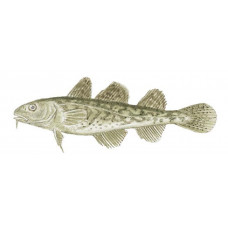Latin name
Microgadus tomcod
Other names
Tomcod; French: poulamon atlantique; Spanish: microgado.
Identification
Characteristic of the cod family, the Atlantic tomcod has three dorsal and two anal fins, which are rounded, as is the tail fin. The body is heavy, and the mouth is large, subterminal. The eyes are small. The coloration of the back is olive-brown, lighter underneath, and the sides are heavily mottled with black spots. The fins have a wavy or mottled pattern. Atlantic tomcod can be distinguished from Atlantic cod by its long, tapering pelvic fins and smaller body.
Distribution
The Atlantic tomcod inhabits waters along the coast of North America from Labrador and the Gulf of St. Lawrence south to Virginia. It is widespread north of Long Island.
Habitat
The Atlantic tomcod lives mostly along the coast, but is known to enter freshwater rivers in winter. It is also landlocked in some Canadian lakes. It lives close to the bottom and is usually found in depths of 2-3 fathoms.
Size
A small species that can be classified as a saltwater fish, the Atlantic tomcod reaches an average of 6 to 12 inches in length. It can weigh up to 1 pound.
Life history and Behavior
The Atlantic tomcod spawning period lasts from November to February. It spawns in brackish or salt water. The eggs sink to the bottom and attach to algae and rocks.
Food and feeding habits
The Atlantic tomcod uses its chin and pelvic fins to locate and inspect food. It feeds on small shrimps, amphipods, worms, clams, squid, and small fish.
Reproduction
No information
| Classification | |
| Phylum | Chordata |
| Class | Actinopterygii |
| Squad | Gadiformes |
| Family | Gadidae |
| Genus | Microgadus |
| Species | M. tomcod |
| Features | |
| Conservation status | Least Concern |
| Habitat | Littoral |
| Life span, years | No information |
| Maximum body weight, kg | 0.4 |
| Maximum length, cm | 35.56 |
| Sailing speed, m/s | No information |
| Threat to people | Edible |
| Way of eating | Predator |


